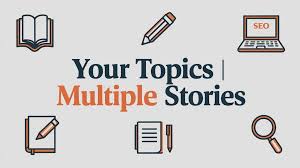In today’s fast-paced digital world, storytelling has become an essential tool for engagement, education, and entertainment. Whether you’re a content creator, journalist, or casual reader, having access to your topics | multiple stories can enrich your perspective and broaden your understanding of various subjects. This article delves into the importance of multiple narratives, how they shape our views, and the best ways to explore diverse stories for personal and professional growth.
Why Are Multiple Stories Important?
The Power of Diverse Narratives
In a world filled with different cultures, beliefs, and experiences, multiple stories help us see beyond our immediate environment. Stories shape perceptions, challenge stereotypes, and create connections between individuals and communities. By exploring your topics | multiple stories, we gain insights that may otherwise remain hidden.
Also Read: Exploring Crypto30x.com Gigachad A Comprehensive Guide
Breaking Stereotypes and Bias
One of the key benefits of engaging with multiple stories is the ability to break stereotypes. Media and history have often presented single-sided narratives, reinforcing specific ideologies. By diversifying our reading and listening habits, we can counteract these biases and develop a more well-rounded worldview.
Exploring Your Topics Through Multiple Stories
Finding Stories That Matter
The internet is a vast repository of information, and selecting meaningful content requires discernment. Whether you’re interested in politics, technology, fashion, or personal development, exploring your topics | multiple stories will help you gain deeper insights.
Where to Find Multiple Stories?
- News Websites & Blogs: Platforms like BBC, CNN, and independent blogs offer different perspectives on global and local events.
- Social Media: Twitter, Reddit, and Medium allow individuals to share their unique experiences and viewpoints.
- Books & Documentaries: Exploring well-researched books and films can provide in-depth knowledge on a subject.
- Podcasts & Interviews: Listening to diverse voices through podcasts enriches understanding and exposes you to various ideas.
The Role of Storytelling in Different Fields
Journalism and News Reporting
Journalists rely on multiple sources to ensure accurate reporting. A single event can be portrayed differently depending on the source, and responsible journalism seeks to present all sides. Reading from different outlets ensures you get a balanced perspective.
Marketing and Brand Storytelling
For businesses, storytelling is crucial in building brand identity. Companies that craft engaging, relatable stories attract more customers. A brand that shares customer success stories, behind-the-scenes moments, and diverse narratives can create a loyal following.
Education and Learning
Educators use storytelling as a powerful tool to make subjects engaging. Historical events, scientific discoveries, and literary works all become more relatable through compelling narratives. Students who engage with your topics | multiple stories develop better analytical and critical thinking skills.
How to Tell a Great Story?
Elements of a Compelling Story
Regardless of the platform, every great story contains essential elements:
- Relatable Characters – Audiences connect with characters that reflect their own struggles, dreams, and emotions.
- Conflict & Resolution – A gripping story presents a challenge and leads to a satisfying conclusion.
- Authenticity – Real experiences and emotions make stories more engaging.
- A Strong Message – Every story should leave the audience with something valuable to reflect on.
Tips for Writing and Sharing Multiple Stories
- Use Multiple Perspectives: Avoid telling stories from just one angle; incorporate different viewpoints.
- Keep It Engaging: Use compelling language, vivid descriptions, and emotional depth.
- Leverage Different Formats: Blogs, videos, podcasts, and social media posts all offer unique storytelling opportunities.
- Encourage Dialogue: Allow audiences to engage with and interpret stories in their own way.
FAQs
1. What is the significance of multiple stories in media?
Multiple stories provide a broader, more inclusive perspective on issues, reducing misinformation and bias.
2. How can I find reliable sources for diverse narratives?
Explore reputable news sites, read books from different authors, listen to podcasts, and follow independent content creators.
3. Why is storytelling important in branding?
Storytelling humanizes a brand, builds emotional connections, and increases customer engagement.
4. How can I improve my storytelling skills?
Practice writing, read widely, experiment with different formats, and seek feedback from your audience.
5. Can multiple stories help in education?
Yes, using different narratives makes learning more engaging, helping students understand complex subjects better.
Conclusion
Engaging with your topics | multiple stories allows us to see the world from different angles, fostering empathy, critical thinking, and informed decision-making. Whether you’re reading the news, crafting marketing campaigns, or educating others, embracing diverse narratives will always enrich your perspective.
By exploring multiple stories, you become more aware, knowledgeable, and open-minded, ultimately leading to a more connected and understanding society.
In today’s fast-paced digital world, storytelling has become an essential tool for engagement, education, and entertainment. Whether you’re a content creator, journalist, or casual reader, having access to your topics | multiple stories can enrich your perspective and broaden your understanding of various subjects. This article delves into the importance of multiple narratives, how they shape our views, and the best ways to explore diverse stories for personal and professional growth.
Why Are Multiple Stories Important?
The Power of Diverse Narratives
In a world filled with different cultures, beliefs, and experiences, multiple stories help us see beyond our immediate environment. Stories shape perceptions, challenge stereotypes, and create connections between individuals and communities. By exploring your topics | multiple stories, we gain insights that may otherwise remain hidden.
Breaking Stereotypes and Bias
One of the key benefits of engaging with multiple stories is the ability to break stereotypes. Media and history have often presented single-sided narratives, reinforcing specific ideologies. By diversifying our reading and listening habits, we can counteract these biases and develop a more well-rounded worldview.
Exploring Your Topics Through Multiple Stories
Finding Stories That Matter
The internet is a vast repository of information, and selecting meaningful content requires discernment. Whether you’re interested in politics, technology, fashion, or personal development, exploring your topics | multiple stories will help you gain deeper insights.
Where to Find Multiple Stories?
- News Websites & Blogs: Platforms like BBC, CNN, and independent blogs offer different perspectives on global and local events.
- Social Media: Twitter, Reddit, and Medium allow individuals to share their unique experiences and viewpoints.
- Books & Documentaries: Exploring well-researched books and films can provide in-depth knowledge on a subject.
- Podcasts & Interviews: Listening to diverse voices through podcasts enriches understanding and exposes you to various ideas.
The Role of Storytelling in Different Fields
Journalism and News Reporting
Journalists rely on multiple sources to ensure accurate reporting. A single event can be portrayed differently depending on the source, and responsible journalism seeks to present all sides. Reading from different outlets ensures you get a balanced perspective.
Marketing and Brand Storytelling
For businesses, storytelling is crucial in building brand identity. Companies that craft engaging, relatable stories attract more customers. A brand that shares customer success stories, behind-the-scenes moments, and diverse narratives can create a loyal following.
Education and Learning
Educators use storytelling as a powerful tool to make subjects engaging. Historical events, scientific discoveries, and literary works all become more relatable through compelling narratives. Students who engage with your topics | multiple stories develop better analytical and critical thinking skills.
How to Tell a Great Story?
Elements of a Compelling Story
Regardless of the platform, every great story contains essential elements:
- Relatable Characters – Audiences connect with characters that reflect their own struggles, dreams, and emotions.
- Conflict & Resolution – A gripping story presents a challenge and leads to a satisfying conclusion.
- Authenticity – Real experiences and emotions make stories more engaging.
- A Strong Message – Every story should leave the audience with something valuable to reflect on.
Tips for Writing and Sharing Multiple Stories
- Use Multiple Perspectives: Avoid telling stories from just one angle; incorporate different viewpoints.
- Keep It Engaging: Use compelling language, vivid descriptions, and emotional depth.
- Leverage Different Formats: Blogs, videos, podcasts, and social media posts all offer unique storytelling opportunities.
- Encourage Dialogue: Allow audiences to engage with and interpret stories in their own way.
FAQs
1. What is the significance of multiple stories in media?
Multiple stories provide a broader, more inclusive perspective on issues, reducing misinformation and bias.
2. How can I find reliable sources for diverse narratives?
Explore reputable news sites, read books from different authors, listen to podcasts, and follow independent content creators.
3. Why is storytelling important in branding?
Storytelling humanizes a brand, builds emotional connections, and increases customer engagement.
4. How can I improve my storytelling skills?
Practice writing, read widely, experiment with different formats, and seek feedback from your audience.
5. Can multiple stories help in education?
Yes, using different narratives makes learning more engaging, helping students understand complex subjects better.
Conclusion
Engaging with your topics | multiple stories allows us to see the world from different angles, fostering empathy, critical thinking, and informed decision-making. Whether you’re reading the news, crafting marketing campaigns, or educating others, embracing diverse narratives will always enrich your perspective.
By exploring multiple stories, you become more aware, knowledgeable, and open-minded, ultimately leading to a more connected and understanding society.


